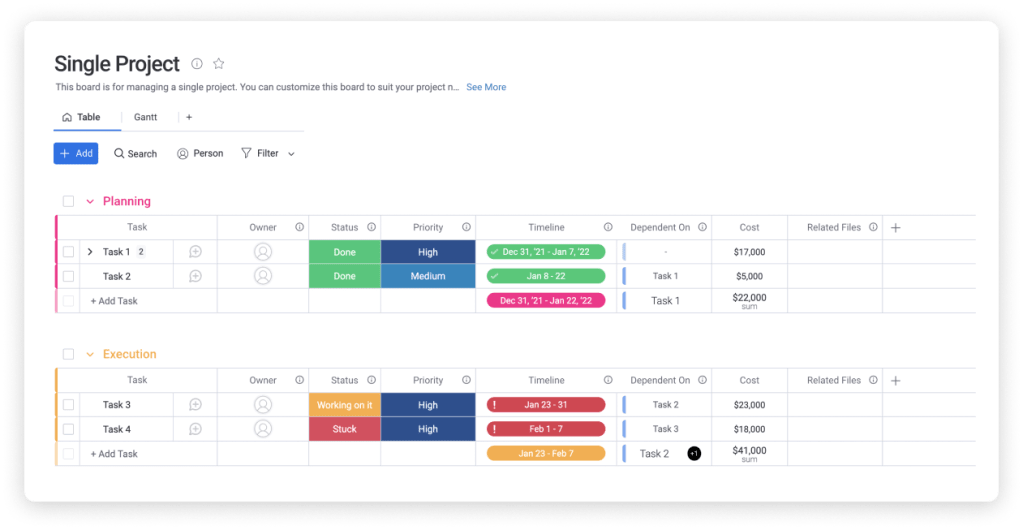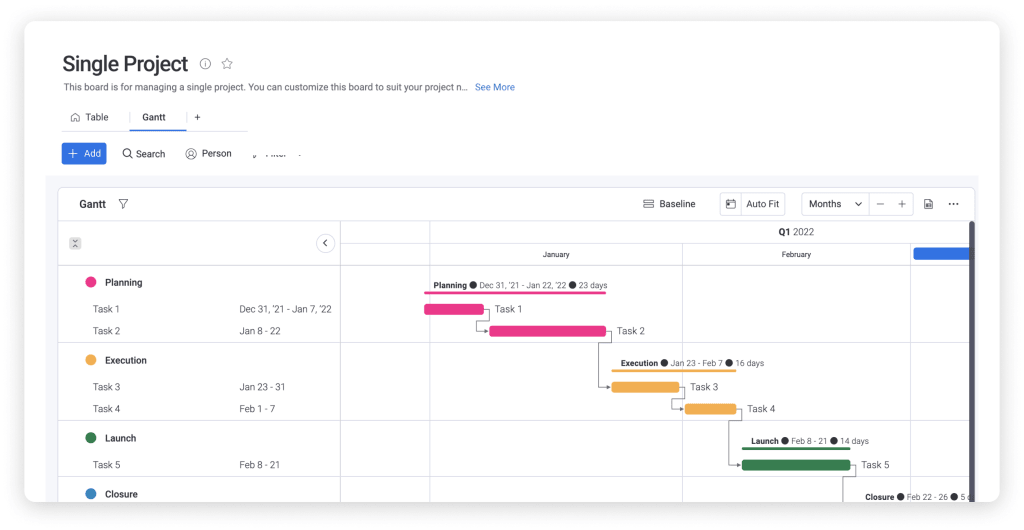You’ve dedicated time and effort into your project, from initiating and planning to executing and monitoring. The only thing left to do is review your deliverables and share them with your client or stakeholders. Project closure templates can help you seamlessly transition to this final step.
We’ll review how project closure templates make it easy to examine, compare, and share deliverables, leading to the successful completion of the project management cycle. We’ll also include a customizable template you can use on monday.com Work OS.
Before we show some templates, let’s refresh ourselves on the purpose of a template at this specific stage in the project.
What is a project closure template?
Project closeout is the final stage of the project management cycle. It involves examining deliverables — or project outputs — and comparing them to the intended project outcome. You then share the deliverables with the project client. The objective is to conclude the project and assess the project’s success. Teams typically document this step in a project closure report.
A project closure template is a pre-formatted tool team members can use to quickly document information on deliverables. It also provides an organized way to present project outcomes to clients. Apart from documentation purposes, there are several other reasons to use a template here.
Read also: our latest article on creating project closure.
Why use a project closure template?
Project closure templates are useful resources for completing projects. In addition to expediting the final stages of a project, they help reduce opportunities for error towards the end. Their purpose is to help teams finish projects as quickly and accurately as possible.
A high-quality template provides clear guidelines on what information to include, reducing the risk of teams forgetting essential details.
The template also organizes information in a coherent manner, which is important as teams will share it with clients or stakeholders. For example, the template might include a list of success criteria defined at the beginning of the project, along with specific data points that indicate performance.
As a team, you can decide the types of categories you want to use for project closures. For example, you might decide all projects are closed successfully after initial roadblocks because efforts are re-routed to another initiative or because a customer or stakeholder pulled the plug. Once you define those categories, you can create custom templates for each.
Though oftentimes, it’s challenging to know what you need. That’s why it’s helpful to look at a few approaches before starting this step.
What are the five types of project closure?
There are five types of project closures that vary due to the level of completion, timeline, and external constraints. They are:
- Normal: The project is completed and within the expected timeframe
- Premature: The project meets specifications and finishes ahead of schedule
- Perpetual: The project is getting extended continuously due to changes in the constraints
- Change in priorities: The project is cancelled because of changes in constraints
- Failed: This means the project was either cancelled or it failed because it didn’t perform as expected
What are some examples of project closure templates?

Let’s examine some examples of project closure templates you might create for your teams.
Normal project closure templates
You may use a normal project closure template when finishing the project within the expected timeframe. Team members complete every stage — including project planning, executing, and monitoring — without any major issues. Moreover, the deliverables meet the goals and objectives of the project.
Premature project closure template
A premature project closure template is filled out ahead of schedule. Team members may use it when meeting the projected project goals earlier than planned. Generally, you would reference this unexpected completion speed on the template, which is useful for future projects. For example, with this knowledge, teams know to adjust timelines when completing similar projects in the future.
Perpetual project closure template
A perpetual project closure is one that’s repeatedly delayed or changed due to pivots in the project. For example, a team might complete the project late because certain team members were unavailable, or they might change aspects of the project scope because the client made new requests. You meet objectives eventually and complete a project closure template, just past the expected deadline.
Changes in priorities project closure template
In this type of project closure, the entire project is canceled due to changes in priorities that make any further effects illogical, impossible, or unwanted. The new priorities can’t be encompassed within the existing project, even if more time is granted. The only solution is to end the project early.
Failed project closure template
A failed project closure template is designed for projects that don’t succeed. Reasons for failed projects can include cancellation by stakeholders or inability to meet the intended outcome. A failed project closer template lets teams gather information about why the project failed, so they can use those lessons learned to make changes to processes going forward.
A Work OS like monday.com can help you successfully close more projects.
A Work OS gives you and your team the ability to build any process
Organizing, analyzing, and sharing project outcomes with different team members and clients requires time, effort, and strong attention to detail. monday.com offers easy-to-use project management templates and workflow features that can be customized to meet your team’s needs. Here are a few of our top attributes.
Flexible Work OS
An essential part of project closures is organizing and sharing deliverables, which is made easier with our flexible Work OS. Here are a few of our unique components:
- Share data with multiple teams in just seconds with Updates, tagging, and other methods
- Review and compare employee performances — including average time spent on tasks
- Shift focus and rank tasks in terms of priorities using an easy drag and drop function
- Create customized dashboards tailored to employee’s working habits
- Manage, track, and consolidate data with easy document management
Our Work OS lets project leaders quickly share information, leading to faster project closures. It also helps leaders gain a better understanding of performance and which areas need to improve for future projects.
Visual Guides
To successfully close a project, team members must consistently share information and push work down the planned project path. monday.com Work OS has several project management templates let companies organize KPIs in colorful, easy-to-read charts and graphs. This data can be sent to different teams with the click of a button, leading to greater focus and collaboration.
Data isn’t just reserved for internal staff members — our boards let you share information with external contractors and clients. Team members and others can offer feedback on these shared data points and documents, increasing collaboration.
Scheduling Functions
Our customizable boards and templates reduce the likelihood of forgetting essential duties.
By organizing essential project tasks in simple list formats, teams can track requirements and ensure nothing slips under the radar.You can use Gantt views to plan out an entire project step-by-step or rely on workflow automation to move tasks from one person to another seamlessly. Building a workflow lets everyone on your team know what needs to be completed in what order, and it allows you to easily move tasks from one team member to another if someone is away or unable to complete a task within the specified time frame.
The above templates are just the beginning. To support project success even more, there are several other templates you can use in conjunction with the project closures template.
Related templates to project closure templates
Let’s take a look at a couple of other templates to consider for optimizing the project workflow.
Lesson Learned Template
Our Lessons Learned Template is perfect for any team looking to perform a retro. You can use this template to organize what worked well, what didn’t, and preliminary action items and plans going forward.
Project Requests and Approvals Template
Our Project Requests and Approvals Template helps manage incoming project requests by organizing them in one place. Team members stay informed on the current project status, key data, and unexpected changes through real-time notifications.
Project Proposal Template
While a project closure template helps successfully conclude projects, a Project Proposal Template helps teams get off to a good start. It lets teams outline project goals and deliverables, giving members a clear idea of what they’re expected to accomplish and when.
Writing project closure documents is easy when you start with a template. For more insights on how to get started, we’ve answered some frequently asked questions about project closure.
FAQs about project closure templates

How do you write a project closure?
Write a project closure document by including everything stakeholders and others may need to know about the project. The document should include:
- The intended goal of the project
- Any colleagues who assisted on the project
- Any obstacles/challenges that occurred
- The project results
- A request for client or stakeholder feedback
For a foolproof project closure document, try the monday.com project closure template.
How do you close an agile project?
Agile project closure is about quickly and smoothly transitioning and concluding a project. It involves the following steps:
- Handing the project over to the operations team
- Tying up any remaining loose ends like paperwork
- Performing a final review of the project outcome
- Celebrating with the team
Finish projects strong with project closure templates
Project closure templates increase your chance of success with future projects by helping you organize and share data about current efforts. Teams can analyze those efforts and learn from them. Project closure documents also help you communicate critical information about the end of a project to stakeholders.
For the best results, use a customizable template you can tailor to your business or industry needs. You can find plenty of customizable project management templates on monday.com. In the meantime, take the project closure template for a spin on us.
